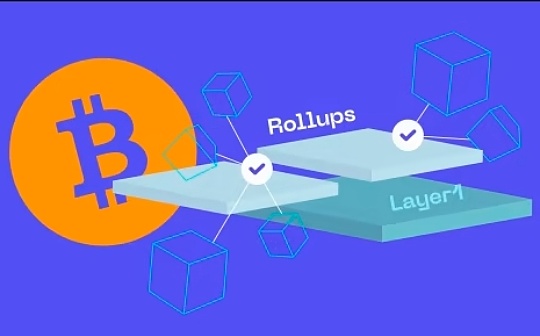
Author: Gabe Parker, Galaxy Research; Compilation: Wuzhu, Bitchain Vision
Preface
Bitcoin’s block space is extremely scarce, with the upper limit of each block being 4 MB.This scarcity presents a significant challenge to Rollups seeking to leverage Bitcoin as a layer of data availability.The emerging Rollups landscape based on Bitcoin is mainly based on ZK, aiming to publish ZK proof output and state differences every 6-8 blocks.However, this approach faces a critical obstacle; each data release consumes up to 400KB (0.4MB) of block space, which actually accounts for 10% of the entire block.
Given that Bitcoin has been at full capacity since January 2023, competition for block inclusion among multiple Rollups will intensify, which may tighten the Bitcoin transaction fee market to unsustainable levels.The current limitations of the Bitcoin base layer, coupled with the surge in Rollups under development, could create an environment where L2 is difficult to afford data release.To remain viable, Rollups on Bitcoin will need to earn a considerable income from transaction fees through useful applications.This report analyzes the economic feasibility of Rollups on Bitcoin by studying data from Ethereum ZK-Rollups and predicting the cost of using Bitcoin for Rollups (to achieve data availability).The analysis explores the potential impact of these projects on Bitcoin blocks after they are launched on the mainnet and discusses alternative strategies that Rollups may adopt if the cost of publishing data to Bitcoin is too high.
Is Bitcoin L1 a data availability layer?
Bitcoin Rollups that publish data to the underlying layer will face a major problem: the cost of publishing data.Bitcoin block space is the most expensive per byte in all chains.In addition, Bitcoin’s block size is strictly limited to 4 MB, and the fees are pegged to the data weight of the transaction, which makes the execution cost of any data-intensive transaction very high.The emergence of ordinal numbers (inscriptions attached to a single Satoshi) highlights that transactions that account for a large portion of the block size require additional fees and drive up transaction fees.For example, the first 4MB Bitcoin transaction etched by the Taproot Wizards team (block 774,628) is $147,000.
According to conversations with several teams that built ZK-Rollups on Bitcoin,Rollups expects to publish ZK-Proof output and status differences in inscriptions to Bitcoin L1 every 6-8 blocks (1 hour – 1.2 hours), Inscription is any data stored in the transaction isolation witness section.This data will enable any participant running a Bitcoin node to rebuild the latest state of Rollup.Based on the testnet and conversations with developers, we estimate that up to 400KB (0.4MB) is required every time the proof output and state differences are published to Bitcoin’s Layer 1 blockchain.
When comparing Bitcoin with the number of megabytes processed per second by Ethereum and Celestia, it is obvious that Bitcoin has never been designed as a DA layer.

Cost of Verification Proof – Ethereum ZK-Rollups
Drawing from Ethereum’s Rollup ecosystem, ZK-Rollups has become a capital-intensive operation because of its use of proof of effectiveness.This approach requires the prover to publish ZK-Proof and transaction data or status differences for each L2 state change.Unlike the Optimistic Rollup extension solution that pays for verification costs only in case of fraud disputes (rare occurrences), ZK-Rolups pays for verification costs in advance by publishing proof of validity.ZK Rollup has high upfront costs and can achieve instant termination (while Optimistic Rollup’s challenge window is about 7 days).The chart below shows the weekly data release cost of ZK-Rollups on Ethereum.

ZK-Rollups pays for data release fees through L2 transaction fees revenue.Since its launch, ZK-Sync Era has proven the feasibility of the model, earning $66.9 million in total revenue from L2 transaction fees.Of this, $51.2 million is spent on ZK verification and L1 call data costs.ZK-Sync has successfully processed over 417.6 million transactions for 5.4 million users, with an average cost per transaction of $0.16.This efficient operation brought in a total profit of $15.7 million.
Estimate the cost of publishing data to Bitcoin
On Bitcoin L1, data is published every 6 blocks, with a fee of 400KB and as low as 10 sat/vByte, and Rollups on Bitcoin will pay $2,640 for each published block.With data published every 6 blocks, Rollups on Bitcoin will pay up to $1.9 million per month to publish to 730 blocks ($23 million per year).Using the 50 sat/vByte level will increase the monthly data release cost to nearly $9.6 million ($115 million per year).It should be noted that with the emergence of Ordinals, BRC-20s and Runes, the rate environment of Bitcoin is now becoming increasingly unstable, so estimating future sat/vByte levels is extremely difficult.
To offset the high cost of posting data in a world of 400KB per post, ZK-Rollups, which uses Bitcoin to provide data, generates approximately $1.9 million to $9.63 million in revenue per month from L2 transaction fees.The sensitivity table below estimates the transaction activity and rate levels required by Bitcoin Rollup to break even after deducting the cost of data release.Our model predicts that as of July 23, 2024, Rollup’s weekly cost of releasing 400KB data to Bitcoin L1 for every 6 blocks is 10, 20, and 50 sats/vByte.If Bitcoin Rollup processes 20 million transactions per month (compared with ZK-Sync’s weekly transaction volumes over the past year), a transaction fee of $0.096, $0.193, and $0.482 is required to charge transaction fees of $10, 20 and 50 sats/The level of vByte achieves breakeven.It should be noted that due to the lack of available data on the test network, this sensitivity table assumes that the 400KB data release size is fixed between 1 million and 80 million transactions per month.We understand that the data publishing size may be greater or less than 400KB depending on the number of transactions included in the status difference.

Rollup, which cannot provide enough transaction fees to cover the cost of data release, will need to use its vault to pay the L1 transaction fees and may eventually be forced to stop using Bitcoin as the DA layer.Other options include publishing ZK proofs and status differences on more cost-effective DA layers such as Celestia, Near, or Syscoin.However, using something other than Bitcoin as a DA layer reduces the layer’s ability to call itself “Bitcoin Rollup.”If the Layer 2 network does not aggregate to Bitcoin, will it still be considered a Bitcoin Rollup, or will it be transformed into a Validium chain that replaces the DA network?Another potential solution for Rollup, which is difficult to pay for costs, is to reorganize into a Tier 3 solution.In this case, Rollup publishes the state difference to layer 2 or sidechain, while only the merkle root hash publishes to layer 1.This approach can significantly reduce data release costs while maintaining connections to the Bitcoin network.
Bitcoin block space when Rollups starts
Since the appearance of Ordinals and BRC-20 in early 2023, Bitcoin’s average daily block weight has been slightly below its 4m unit of weight limit (4MB data).Block weight is a dimensionless measurement of block “size” and is introduced in SegWit upgrades to include discount witness data.Due to the influx of a large number of inscription-related transactions, the average daily block weight has increased significantly, including arbitrary data (text, images, etc.) in the transaction isolation witness field.Since February 2023, the average fullness of Bitcoin blocks has been 98%.

If each proof output and state difference totals 400k weight units, a single Rollup publishes data to a block if the data size of the Rollup remains consistent, which will take up 10% of the block weight limit.Given that the block is always at full load, introducing Rollup will change the composition of transaction data within each data publishing block.The following figure shows the block composition of 30 block samples on July 18, 2024, assuming that two Rollups are active and data is published every 6 blocks.

Rollups publishes data on Bitcoin L1 every 6-8 blocks, and the ongoing demand for block space will force time-sensitive transactions to pay a premium before or during the data release block.The following figure highlights how intensified competition in Runes and Ordinals on-chain activity forces time-sensitive transactions, also known as financial transactions, to pay the highest rate premium.

Why Bitcoin DA is important
In order for Rollup to be exactly consistent with Bitcoin, it must leverage Bitcoin to enable data availability.Although expensive, this choice takes advantage of Bitcoin’s unrivalled security, immutability and decentralization.Rollup, which chooses an alternative DA solution, introduces additional trust assumptions outside the Bitcoin network, which may damage its integrity and the classification of “Bitcoin Rollup”.The advantage of Bitcoin as a DA layer is not only its strong security, but also its extensive node distribution and low threshold for setting light or full nodes.This accessibility ensures that anyone running a full Bitcoin node can rebuild Rollup’s latest L2 state, thereby enhancing transparency and decentralization.
Despite the high expense and potential long-term feasibility challenges, Bitcoin’s role as Rollup’s original DA layer highlights a fundamental trade-off: leveraging the high cost of leveraging the unparalleled security and decentralization it provides.This balance between cost and security could shape the future landscape of Rollup implementation on the Bitcoin network.
Rollups Outlook for DA with Bitcoin
-
ZK-Rollups for data availability using Bitcoin will need to generate approximately $1.9 million to $9.6 million in monthly revenue from L2 transaction fees to operate in a 10-50 Sat/vByte rate environment.
-
The fee estimation engine is crucial for Rollups on Bitcoin to maximize profits.
-
The Bitcoin block space simply cannot support 4-8 Rollups issued for every 6-8 blocks.
-
Teams that will build sovereign Rollup on Bitcoin will need to use the app to execute a listing strategy that allows users to trade on L2.
-
Some Bitcoin L2 will explore the L3 environment to execute transactions and use a combination of L2 and Bitcoin L1 to provide data availability.
-
Rollups on Bitcoin will increase competition for block inclusion, thereby increasing L1 fees for everyone, including Rollups itself.
-
Bitcoin L2 using Bitcoin L1 for DA will require hedging unexpected volatility expense soaring through rate derivatives markets and out-of-band mining transactions.








